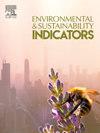Indicators of scientific production show limited and fragmented information for integrated aquatic quality on La Plata River transboundary basin
IF 5.4
Q1 ENVIRONMENTAL SCIENCES
引用次数: 0
Abstract
The La Plata River Basin (LPRB) is the second-largest basin in South America, encompassing five countries: Argentina, Brazil, Bolivia, Paraguay, and Uruguay. It spans diverse regions, from the Andean mountains to the Pantanal wetlands, and from arid areas to the Pampas biome. Major cities are situated along the rivers, all facing different environmental pressures. Records of water quality assessments are scarce and fragmented, and there is no available comprehensive environmental quality study involving all five countries across the entire basin. Here we perform a bibliometric and science mapping analysis to describe the scientific knowledge and institutional collaboration of monitoring aquatic environments in the entirely basin. We searched and selected articles for each major river comprising the basin and with specific keywords related to monitoring and environmental assessments in two bibliographic repositories (SciELO and Scopus). There were 357 documents published in SciELO and 672 in Scopus on monitoring water quality in the LPRB from 1977 to 2023. Results show that there is limited information on the environmental quality aspects of the LPRB. No publications cover the entire basin and all five countries. Most studies have been conducted in the estuarine region and particular sub-basins of Brazil, Argentina, and Uruguay. Despite the studies on the basin for more than 5 decades, there is an urgent need to integrate the entire basin in research efforts to develop comprehensive monitoring programs for sustainable environmental management.
科学生产指标表明,拉普拉塔河跨界流域综合水质信息有限且碎片化
拉普拉塔河流域(LPRB)是南美洲第二大流域,包括五个国家:阿根廷、巴西、玻利维亚、巴拉圭和乌拉圭。它横跨不同的地区,从安第斯山脉到潘塔纳尔湿地,从干旱地区到潘帕斯生态群落。主要城市都坐落在河边,都面临着不同的环境压力。水质评估的记录很少,而且支离破碎,没有涉及整个流域所有五个国家的全面环境质量研究。本文通过文献计量学和科学制图分析来描述整个流域水生环境监测的科学知识和机构合作。我们在两个文献库(SciELO和Scopus)中搜索并选择了包含流域的每条主要河流的文章,并使用了与监测和环境评估相关的特定关键词。1977年至2023年,SciELO和Scopus分别发表了357篇和672篇关于LPRB水质监测的论文。研究结果表明,关于低海拔沿岸线环境质量方面的信息有限。没有出版物涵盖整个盆地和所有五个国家。大多数研究是在巴西、阿根廷和乌拉圭的河口地区和特定的次盆地进行的。尽管对该流域的研究已经进行了50多年,但迫切需要将整个流域纳入研究工作,以制定全面的可持续环境管理监测方案。
本文章由计算机程序翻译,如有差异,请以英文原文为准。
求助全文
约1分钟内获得全文
求助全文
来源期刊

Environmental and Sustainability Indicators
Environmental Science-Environmental Science (miscellaneous)
CiteScore
7.80
自引率
2.30%
发文量
49
审稿时长
57 days
 求助内容:
求助内容: 应助结果提醒方式:
应助结果提醒方式:


